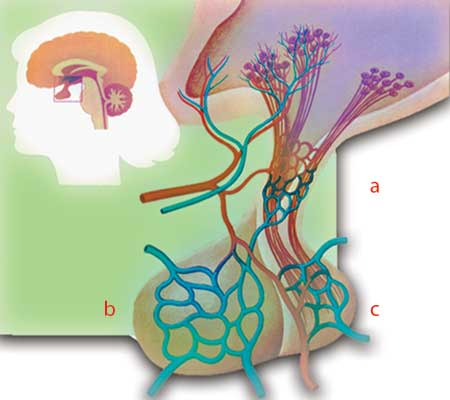The hormone vasopressin has yet another ability: It can constrict the blood vessels and thus raise blood pressure. This specially designed security system is yet another proof that human beings were brought into existence through a special creation. In order for this system to be able to function at all, wide-ranging planning has been carried out. Very special receptors that measure blood pressure are located inside the blood vessels extending from the auricle of the heart and entering the heart itself.
It is well-known that technological devices must be employed to measure blood pressure. These instruments are developed through the co-operation of experts in various different fields, and manufactured using advanced technology. Yet in our hearts, tiny molecules, invisible to the naked eye, perform the same task. These consist of molecules with no sensory organs, nor any consciousness with which to perceive whatever they might feel. How can these receptors measure blood pressure and perceive the subtle differences? In addition, how did these receptors come to be located in the heart, in exactly the right place? The answer to all these questions reveals the existence of God and the glory of His creation.
The nerves departing from these receptors are connected to the pituitary gland, just like a cable connection. Under conditions of normal blood pressure, these receptors are constantly stimulated to send a continual electrical current to the pituitary gland by means of these nerves (Figure 11). So long as the pituitary gland continues to receive these signals, it will prevent the secretion of the hormone vasopressin. The ever-ready members of the security system never go into action, as long as they receive "all clear" messages from the center where the system is established.1
So when does this security firm, the pituitary gland, go into action? In the event of any serious bleeding, the body loses a lot of blood, and the volume of blood—and hence, the blood pressure—in the veins is reduced, presenting a grave danger for the patient.
The moment that blood pressure falls, the receptors in the blood vessels send a signal to the pituitary gland, and the heart is interrupted. This causes the pituitary gland to sound the alarm and to secrete the hormone vasopressin (Figure 12). When the pituitary gland realizes that the signal has been interrupted, it immediately displays what seems to be an exceptionally conscious piece of behavior—amazing, since this apparently conscious behavior is entirely performed by tiny molecules composed of combinations of particular atoms.
The hormone vasopressin causes the muscles around the blood vessels to contract immediately, which causes blood pressure to rise. This system is actually highly complex, consisting of a number of inter-related components, suggests a great many questions worthy of reflection.
How do the hypothalamus cells that generate the hormone vasopressin know the structure of the muscle cells in the blood vessels located so far away from them?
How have they learned that these vessels must be contracted in order for blood pressure to rise?
How can these cells produce the exact chemical formula that enables this contraction to take place?
 |
| Figure 11: Nerves connect the pituitary gland to sensors in the heart. Under conditions of normal blood pressure, these sensors are constantly stimulated and send a constant electrical current to the pituitary gland. Figure 12: When blood pressure falls, the sensors in the heart cease sending signals to the pituitary gland. This leads to the pituitary gland going into emergency mode and releasing vasopressin. |
How did such a flawless alarm system along the nerves connecting the heart and the pituitary gland come into being?
No doubt that we see here the evidence of an immaculate creation. And this shows that the human body is not the result of a series of blind coincidences, but was brought into being by God's creation. Evolutionists maintain that the body's communication and alarm systems came into being by chance, that the cells spontaneously thought this system up, and then designed and constructed it. But to make such a statement reveals a major collapse in logic. Such a claim is the equivalent of saying that materials such as cement, bricks and electrical cables piled up in an empty field gave rise to a skyscraper as the result of a passing tornado—and then, subsequent storms equipped this skyscraper with an electrical system, and later still, a perfectly functional security system.
No rational person of good conscience could ever accept such a claim. Yet what evolutionists maintain is even more illogical. Determined to deny the existence of God (God is beyond that!), they defend the theory of evolution without considering just how irrational their statements are. In fact, however, Almighty God has brought all things into being through a perfect creation. The evidence is obvious for all to see.
 |
| a. Anterior pituitary gland |